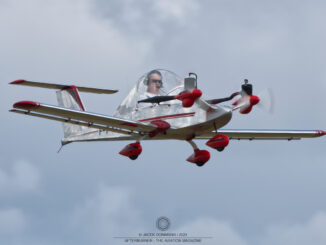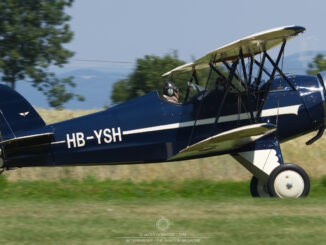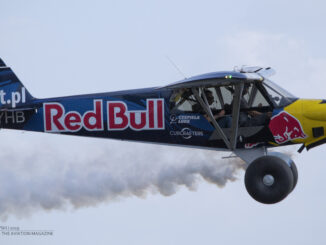 Dassault Mirage IIIDS (c/n MD 470, HB-RDF, formerly ´J-2012´ of the Swiss Air Force), static display at the 75th Anniversary of Meiringen airfield, Meiringen, June 2016.
Dassault Mirage IIIDS (c/n MD 470, HB-RDF, formerly ´J-2012´ of the Swiss Air Force), static display at the 75th Anniversary of Meiringen airfield, Meiringen, June 2016.
In the early 1950s, the French Ministry of Defence issued specification for a new, lightweight single-engine, supersonic all-weather interceptor aircraft. It was responded by three domestic aircraft manufacturers, Sud-Est that offered SE.212 Durandal, Sud-Ouest with SO.9000 Trident and Dassault Aviation with its MD.550 concept.
The MD.550, also known as Mystére Delta, was partially based on the already successful concept of the early Dassault jets which started with Ouragan (first flight in February of 1949) and then was developed into Mystére I-IV fighter bombers (maiden flights in 1951 and 1952). The aircraft was built in a tailless delta configuration and powered by single Armstrong Siddeley MD30R Viper turbojet engine. On 25th June 1955, the prototype of MD.550 performed its maiden flight.
The evaluation flights of the new Dassault fighter showed some drawbacks of the proposed delta configuration, such as long take-off, high landing speed, limited manoeuvrability and high level of vibrations at low altitudes. In result, the MD.550 was significantly redeveloped, although still preserving the delta wing.
The second-stage development, now designated Mirage I, received new vertical stabilizer, afterburners and an additional rocket motor. At the end of 1956, the new fighter performed a series of test flights, achieving speed of Mach 1.3 and 1.6, without and with assistance of the rocket motor, respectively.
Nevertheless, comparative tests of the Mirage I, Trident and Durandal proved the concept of lightweight interceptor was essentially wrong. Both the small size and light weight of the fighter caused it could neither carry enough equipment and armament, nor had flight characteristics necessary for the interceptor role.
Undaunted by the results of the test, Dassault continued with development of the Mirage project, trying to change the initial concept into a much bigger aircraft. At the beginning, there was Mirage II, an enlarged variant of the first prototype but shortly after it was replaced by two, even bigger, designs – Mirage III and IV.
And it was the Mirage III that sparked interest from Armée de l’Air (the French Air Force) and received support for further development. The aircraft was powered by single Snecma Atar turbojet engine, with additional rocket booster, new Cyrano Ibis air intercept radar and at that time the newest French avionics. On 17th November 1956, the aircraft performed its maiden flight and soon after, the French Air Force ordered the first ten examples of the Mirage IIIA, within the pre-production series.
The first Mirage IIIA took into the skies in May of 1958. In October of the same year, the fighter achieved speed of Mach 2.2, as the first Western European aircraft to exceed Mach 2 in level flight.
Over the next years, the Mirage III became one of the most-known French jet fighters. Officially introduced into operational service in 1961, the aircraft was used not only by Armée de l’Air but also sold to Argentina, Australia, Belgium, Brazil, Chile, Colombia, Ecuador, Egypt, Gabon, Israel, Lebanon, Libya, Pakistan, Peru, South Africa, Spain, Switzerland, Venezuela and Zaire. Until 1982, when the Mirage III production was ceased, there were more than 1,400 examples of all variants of the aircraft built.
In 1966, the Mirage III was for the first time used in combat, by the Israeli Air Force. Then, the fighter participated in several conflicts all around the world, including the Six-Day War (1966), the Yom Kippur War (1973), the South African Border War (1966-1990), the Indo-Pakistani War (1971) and the Falklands War (1982).
Most of the Mirage III fighters were retired until the early 2000s. However, the Pakistani Air Force still keeps several dozens of those aircraft in active service (although, reportedly, they had to be withdrawn from operational use this year).
In the early 1960s, Switzerland purchased license rights to manufacture the Mirage III fighter by F+W Emmen. Initially, it was planned to build no less than one hundred aircraft but finally the production was limited to only thirty-six Mirage IIIS interceptors, eighteen Mirage IIIRS reconnaissance aircraft and two Mirage IIIDS two-seat trainers.
Contrary to the original aircraft, the Swiss Mirages were equipped with American avionics and radar, could carry the AIM-4 air-to-air missiles and featured different cockpit design. The fighter variant remained in active service until 1999, while the other versions were operated by the Swiss Air Force until 2003.
The Mirage IIIDS ´J-2012´, featured within our Photo of the Week series, was retired from operational service in 2003. The aircraft was offered to Clin d´Ailes Military Aviation Museum in Payerne and, after a long process of obtaining necessary permissions, became the sole civilian-operated Mirage III in the world, registered HB-RDF.
For several years, the Mirage IIIDS participated in aviation events in Europe, as well as was available for passenger flights. Regrettably, at the beginning of 2023, the Swiss aviation authorities decided not to extend its certificate of airworthiness any longer, due to the aircraft age and technical condition.
On 25th May 2023, the Mirage HB-RDF performed its final flight. Then, the aircraft became part of the Clin d´Ailes museum exhibition.



